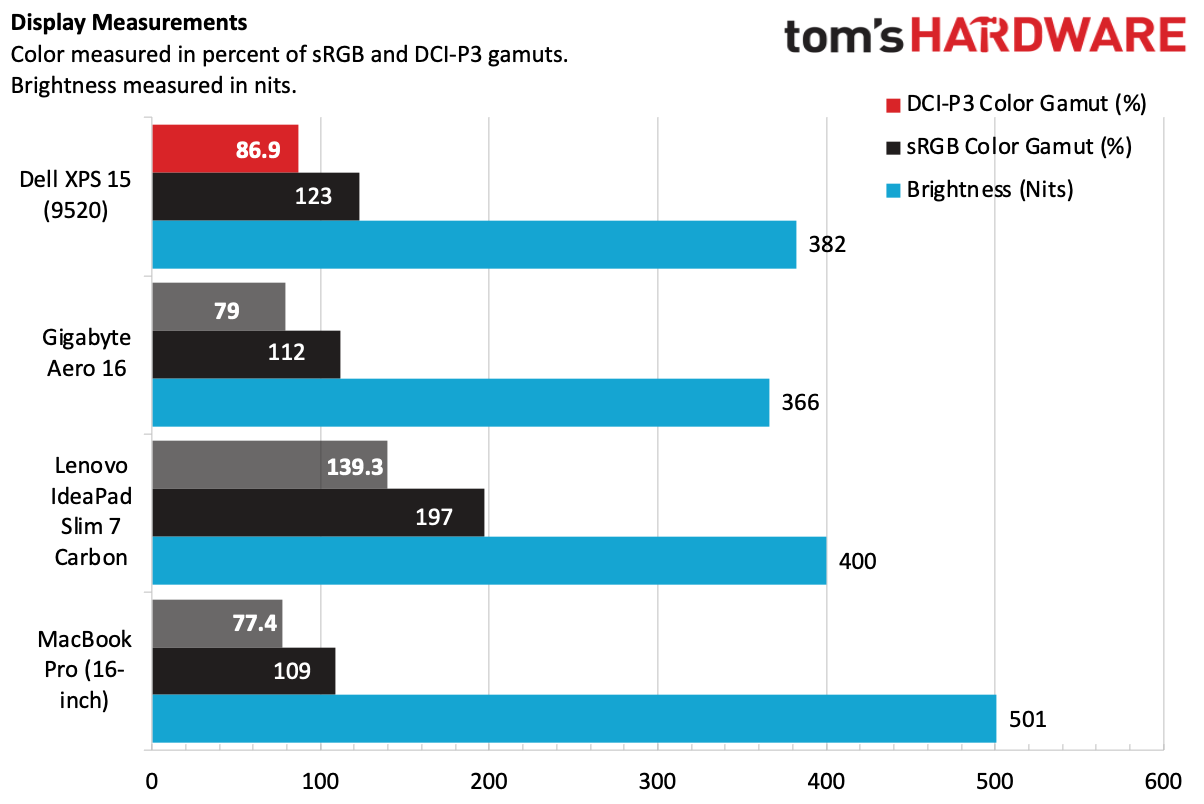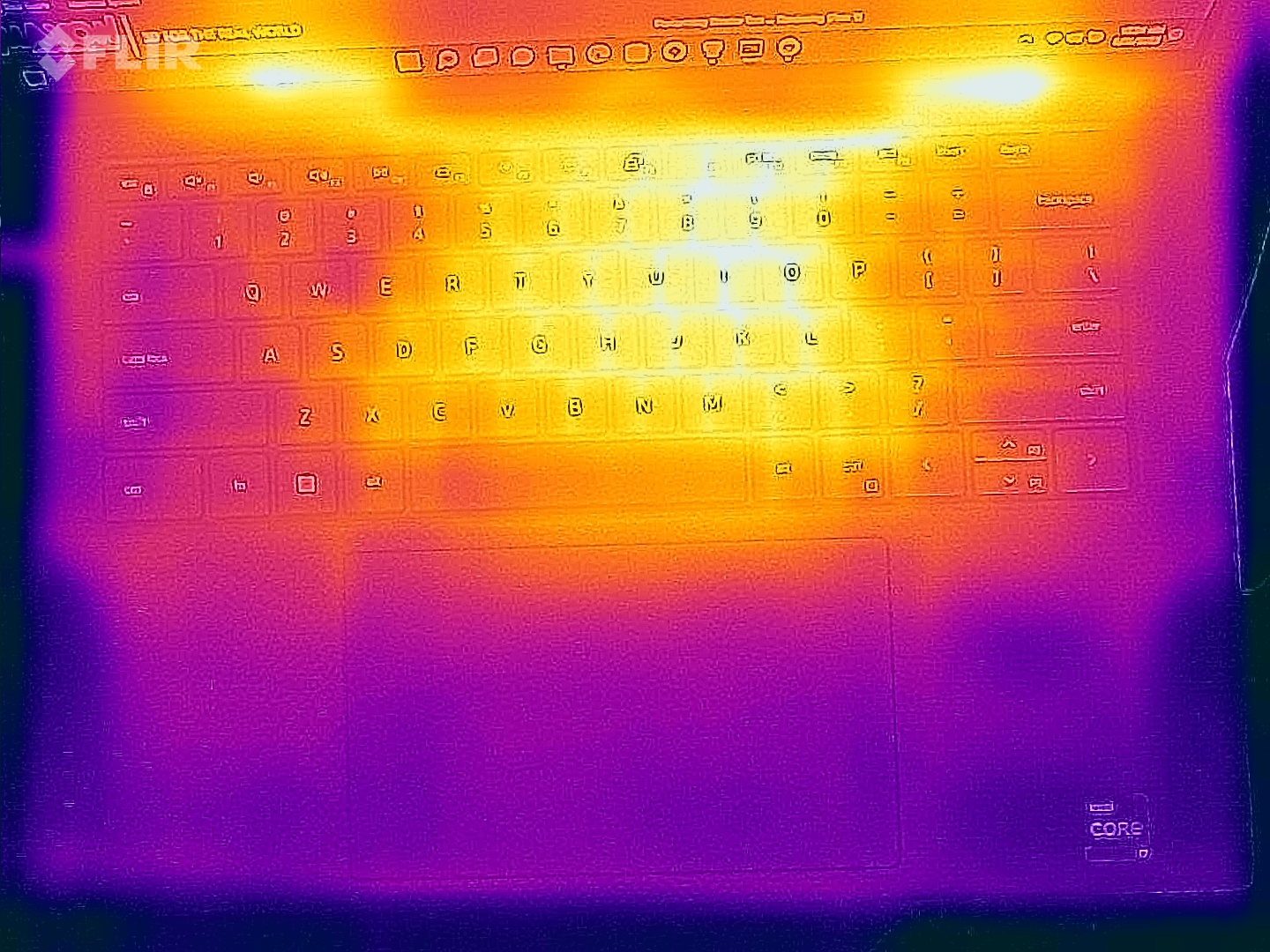Tom's Hardware Verdict
The Dell XPS 15 is a sturdy machine for work or play with strong performance and a lovely display, as long as you can put up with its minimal port selection and a mediocre webcam.
Pros
- +
Sturdy aluminum design
- +
Vivid OLED display
- +
Surprisingly long battery life for the specs
- +
Strong performance
Cons
- -
Limited ports
- -
Middling webcam
Why you can trust Tom's Hardware
Classy yet traditional, powerful yet unassuming, the Dell XPS 15 (9520) is perhaps, at first glance, the consummate PC for those who need to take some power on the go. It's a sturdy, aluminum laptop with a 12th Gen H series Intel processor and up to an Nvidia GeForce RTX 3050 Ti ($1,449 to start, $2,399 as tested).
The XPS line, which has frequented the list of the best ultrabooks, has always been defined by its nearly bezel-free display, and the XPS 9520 is no exception. That made the OLED screen on our review unit appear to nearly float above the keyboard, but Dell still has to work on the webcam a bit.
It's also thin, and while that makes the XPS portable, it also cuts down on ports. You'll have to balance that against the power it offers to see if this is the laptop with the creative abilities you need.
Design of the Dell XPS 15 (9520)
The XPS 15 feels about as premium as a Windows laptop gets these days. It's a solid aluminum block with a silver exterior and a reflective Dell logo. It feels nice and sturdy in the hands. It's such a block, in fact, that there's no divot to open the lid with your thumb. This is a two-hand job.

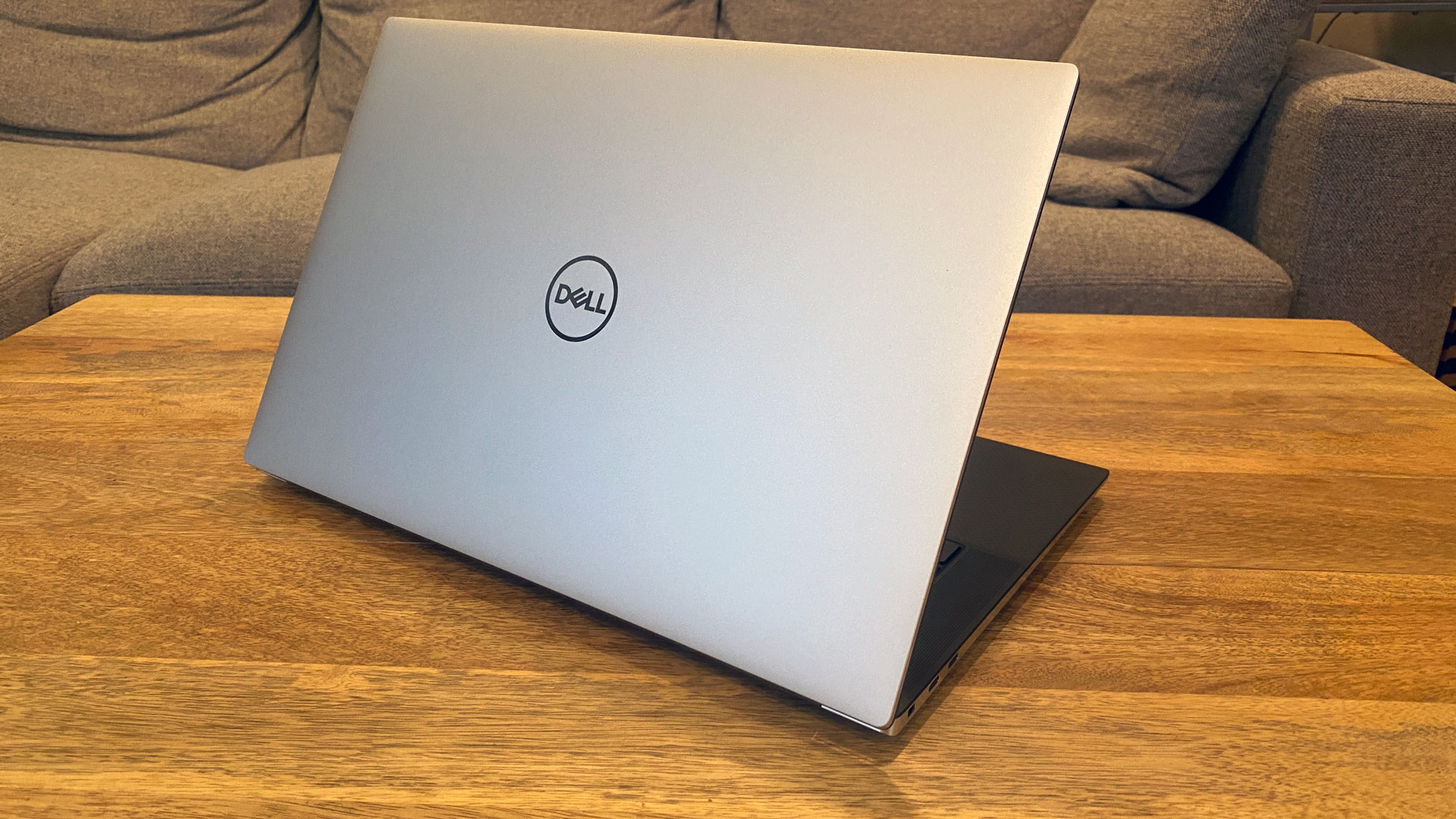
We tested the XPS 15 with black carbon fiber weave on the inside. It's also available in white with a woven glass palm rest, and while that's striking, I'd go for the carbon fiber every time. I've reviewed a number of XPS 15 models, and this one confirms my preference: the carbon fiber is more comfortable against the wrists and palms while you type and use the PC.
The display is surrounded by narrow bezels on all four sides, which is still striking even though Dell has been doing it for years. Even now, typing on it, I'm impressed.
There are a few extra: a fingerprint reader is built into the power button, for instance, though I much prefer using the IR camera to log in with facial recognition.
But with its 0.73-inch thick design, the XPS is limited on ports. On the left side there's a lock slot and a pair of Thunderbolt 4 ports, while the right side has a USB 3.2 Gen 2 Type-C port, an SD card reader and the headphone jack. Dell doesn't label the Thunderbolt 4 ports on the machine itself, so without looking it up on Dell's website (I did!), you can't tell just from looking.
Get Tom's Hardware's best news and in-depth reviews, straight to your inbox.


It used to be that the SD card slot put the XPS 15 a cut above Apple's MacBook Pros. But with the latest 14-inch and 16-inch MacBook Pros, Apple went thicker, and now it has more than just an SD card slot — the Mac has HDMI. Dell is including a dongle in the box with a USB Type-A port and an HDMI output, which helps, but isn't the same as being on the notebook.
The XPS 15 measures 13.56 x 9.06 x 0.73 inches and weighs 4.51 pounds. That's lighter than the 16-inch MacBook Pro (4.8 pounds) and smaller at 14.91 x 9.77 x 0 .66 inches, though that laptop has a bigger screen. The Gigabyte Aero 16, which also has a 16-inch display, is 5.07 pounds and 14.02 x 9.78 x 0.88 inches. The Lenovo IdeaPad Slim 7 Carbon, a 14-inch competitor, is a featherweight in comparison at 2.43 pounds and 12.32 x 8.44 x 0.59 inches.
Dell XPS 15 (9520) Specifications
| CPU | Intel Core i7-12700H |
| Graphics | Nvidia GeForce RTX 3050 Ti (4GB GDDR6, 45W max graphics power, 1,035 MHz boost clock) |
| Memory | 16GB DDR5-4800 |
| Storage | 1TB M.2 PCIe Gen 4 SSD |
| Display | 15.6-inch, 3456 x 2160, 16:10, OLED touchscreen |
| Networking | Intel Wi-Fi 6E AX211, Bluetooth 5.2 |
| Ports | 2x Thunderbolt 4, USB 3.2 Gen 2 Type-C, 3.5mm headphone jack, SD card slot |
| Camera | 720p webcam |
| Battery | 86 WHr |
| Power Adapter | 130 W |
| Operating System | Windows 11 Home |
| Dimensions (WxDxH) | 13.56 x 9.06 x 0.73 inches / 344.4 x 230.1 x 18.54 mm |
| Weight | 4.31 pounds / 1.96 kg |
| Price (as configured) | $2,399.00 |
Productivity Performance on the Dell XPS 15 (9520)
We tested the XPS 15 with an Intel Core i7-12700H, Nvidia GeForce RTX 3050 Ti, 16GB of RAM and a 1TB SSD.
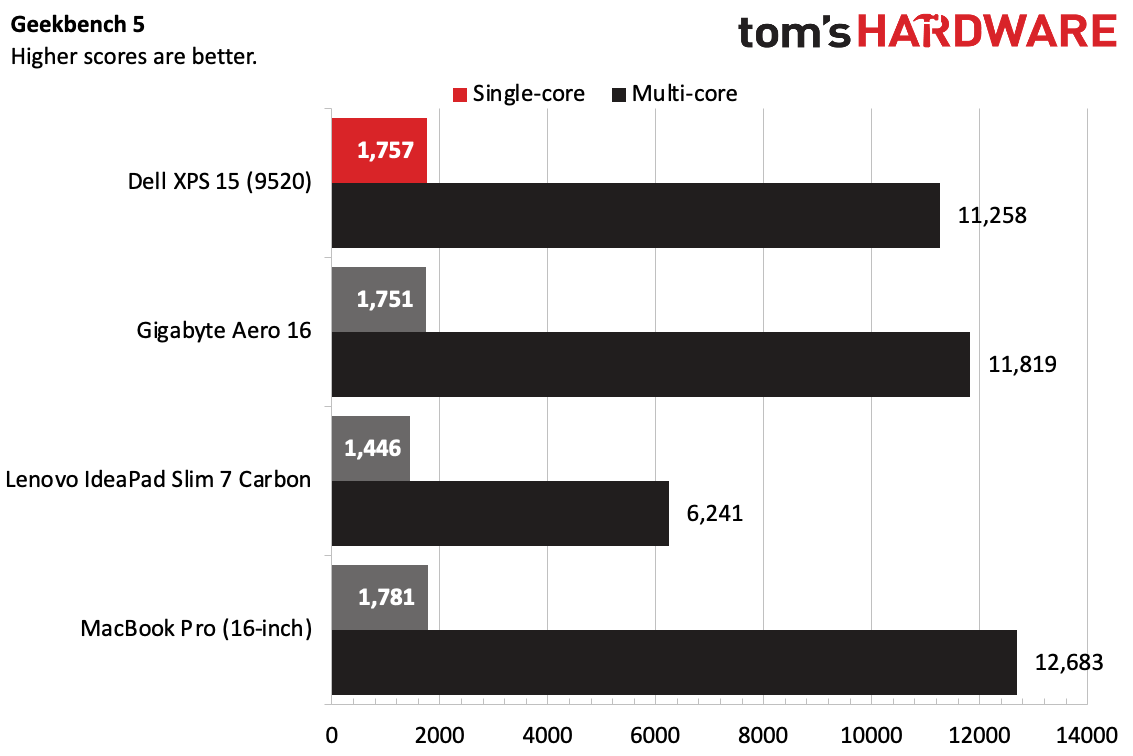
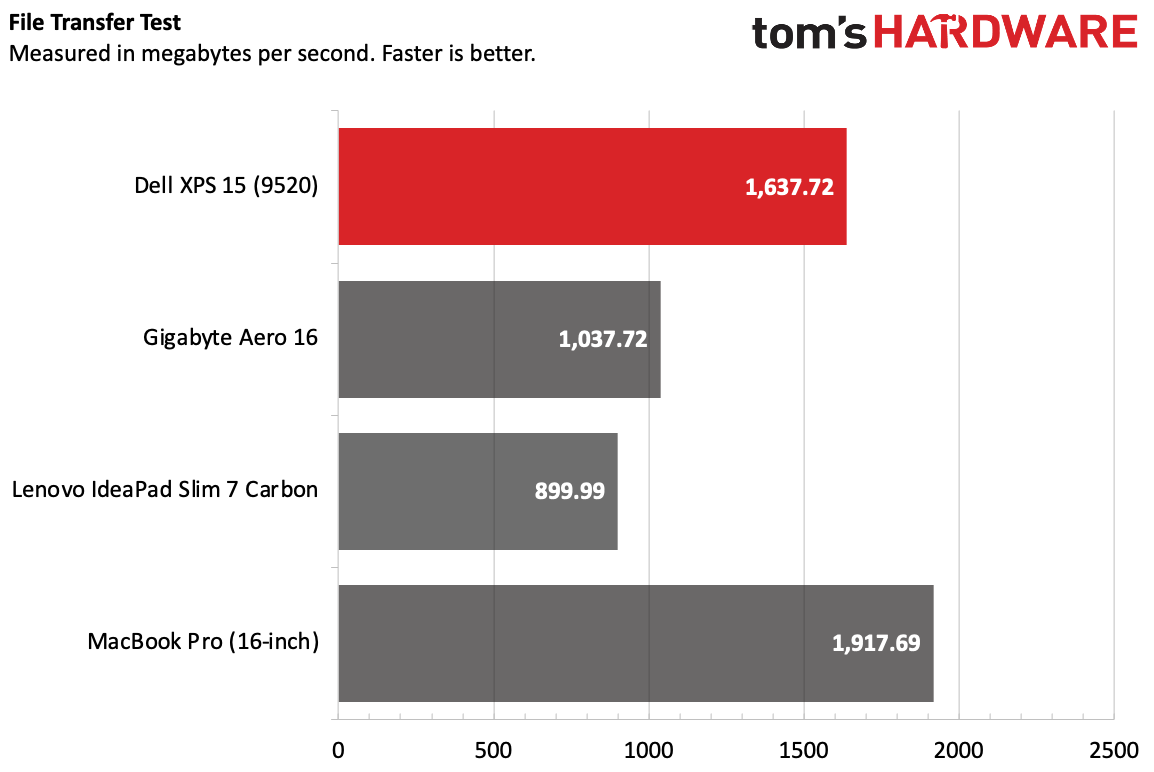
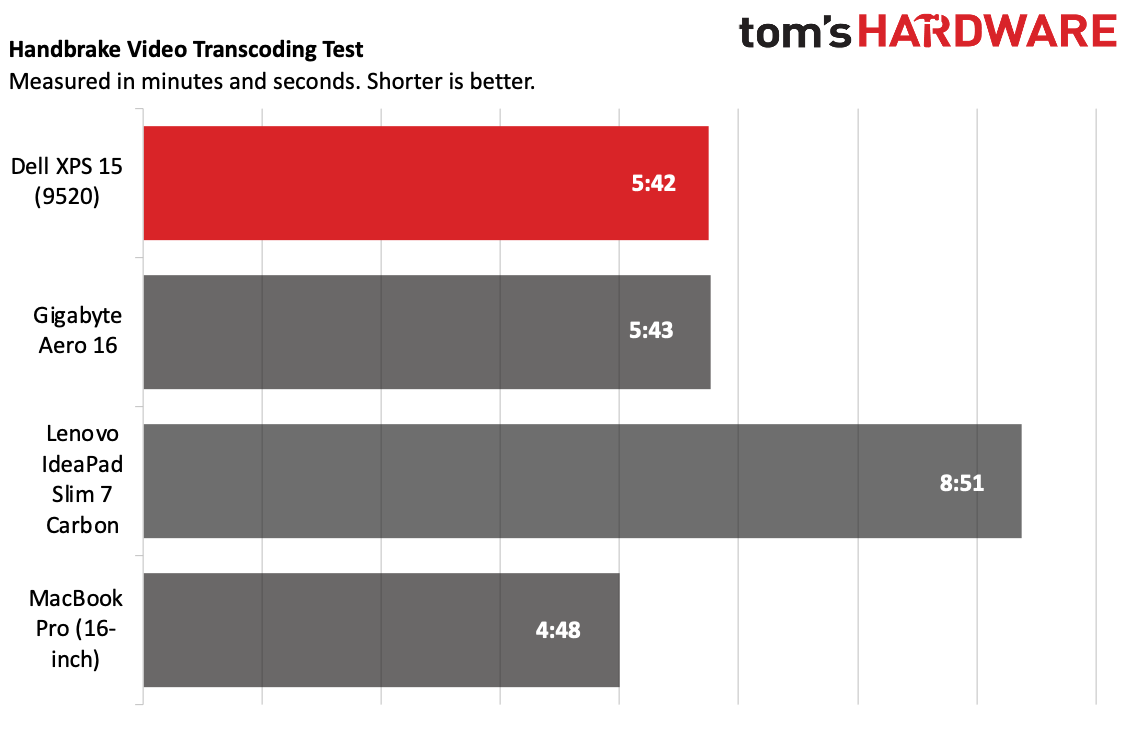
On Geekbench 5, an overall performance test that leans heavily on the CPU, the XPS 15 achieved a single-core score of 1,757 and a multi-core score of 11,258. The single-core scores were on par with the Gigabyte Aero 16 (with the same chip) and Apple's 16-inch MacBook Pro with M1 Max. But the MacBook Pro had a much stronger multi-core performance score (12,683). The IdeaPad Slim 7 Carbon (AMD Ryzen 7 5800U) fell behind in both single and multi-core performance.
Dell's laptop copied 25GB of test files at a rate of 1,637.72 MBps, easily speeding past the Aero and the Ideapad. The MacBook Pro was faster at 1,917.69 MBps.
We use Handbrake to transcode a 4K video to 1080p. Tha took the XPS 15 five minutes and 42 seconds, just one second ahead of the Aero 16 with the same CPU. The MacBook Pro with M1 Max beat it at 4:48.
Our stress test consists of running Cinebench R23 for twenty runs back-to-back. The XPS 15 started at a score of 11,760.82 and vacillated, mostly, within a few hundred points The CPU's performance cores ran at an average of 2.6 GHz and the efficiency cores clocked at 1.6 GHz. It ran at an average of 81.87 degrees Celsius (179.37 degrees Fahrenheit).
Of course, with the RTX 3050 Ti, the Dell XPS 15 can handle some photo or video editing, as well as basic gaming. On 3DMark Fire Strike, it earned a score of 9,534, falling short of the Aero's RTX 3070 Ti (20,917), but beating AMD's integrated Vega graphics in the Lenovo IdeaPad Slim 7 Carbon (3,561).
Display on the XPS 15
The 15-inch OLED touchscreen on the XPS 15 all but floats above the keyboard. Its thin bezels impress despite the fact that so many other computer manufacturers have been shrinking the bars around their panels. The 16:10 aspect ratio provides plenty of room for work, showing more content with less scrolling.
The OLED screen has a resolution of 3456 x 2160, which is not quite 4K, but pretty close (4K, at minimum, is usually defined as 3840 x 2160. 16:9 screens often bump that to 3840 x 2400 due to the extra height.)
Dell's panel is vivid and bright, albeit not the most luminous around. I used it to watch a 4K open source film we use in testing, Tears of Steel, and in the opening scene, as a rocket booster's red flames turned a blinding white, they stood out nicely even against a gray sky.
The XPS 15 covered 85.9% of the DCI-P3 gamut and 123% of the sRGB gamut. That surpasses both the Gigabyte Aero 16 (which also uses OLED) and the MacBook Pro (which has a mini-LED display). The Ideapad Slim 7 Carbon won out here at 139.3 percent of the DCI-P3 gamut and 197% of the sRGB gamut.
Del''s screen measured 382 nits on our lightmeter, beating the Aero but falling slightly behind the IdeaPad (400 nits) and far behind the MacBook Pro (501 nits). In my use, I didn't have an issue with brightness, but having the option is nice, especially if you're a creative on the go.
The OLED screen measures 60 Hz, which is still fairly common. Apple's mini-LED display goes up to 120 Hz with ProMotion turned on.
Keyboard and Touchpad on the Dell XPS 15 (9520)
Dell's keyboard has chiclet keys that are decent, albeit a bit soft and squishy for my tastes. My only real issue, however, is the half-height up and down arrow keys. I wish Dell would switch to an "inverted T" for the arrows.
I typed quickly and accurately on the monkeytype typing test, hitting 109 words per minute with a 98% accuracy rate.
The keys are backlit with white lighting, which can be controlled by a function on the F5 key. Oddly enough, the F9 key has no alternative function at all. I think Dell would be prudent to put a full set of media keys (it only has play/pause, but not next or last keys) and to eliminate the shortcut for adjusting second screen settings in Windows.
The keyboard is nice and roomy, which I always appreciate. It was responsive and worked with all of Windows 11's most complicated gestures. It clicks a bit soft, but I was able to get used to that pretty quickly.
Audio on the Dell XPS 15 (9520)
The speakers on the XPS 15 are quite good by laptop standards. Sure, they get loud, but they also were well-tuned and balanced.
The sounds of The Pretty Reckless' "25" filled my apartment, and didn't distort unless I topped out the volume options. The vocals, strings, and rums also sounded great. The bass was a bit weak, but I was even able to bring a bit more of that out by playing with some dials and equalizers in the included Waves MaxxAudioPro app.
But that sound came at an odd cost: the XPS 15 literally vibrated as I played music. I could feel it with my hands on the wrist rest and even through the keys on the keyboard when I touched them long enough. This happens to some degree on most laptops, (speakers work through vibrations, after all), but it's particularly noticeable on this system.
Upgradeability of the Dell XPS 15 (9520)
The XPS 15's bottom casing is held down by eight Torx T5 screws. Dell should consider switching to Philips heads. We had one screw strip, which is not an ideal situation.
You'll need something to pry the casing off of the system with. Dell's maintenance manual recommends separating the left side, then the right side, before pulling the base off.
The RAM is slotted, so you can upgrade or replace that later. There are two M.2 SSD slots (both are below heat shielding), so if yours only has one filled, you can always add more storage down the line. The battery is also replaceable.
Battery Life on the Dell XPS 15 (9520)
The XPS 15 did quite well on our battery test, especially with both an OLED screen and a discrete graphics card. It lasted for nine hours and 43 minutes on our workload, which involves constantly browsing the web, streaming videos and running OpenGL tests with the display set at 150 nits.
That easily exceeded the Aero 16, which ran for 5:04. The IdeaPad Slim 7 Carbon was in the same ballpark as the XPS 15 at 9:56.
But Apple's 16-inch MacBook Pro, with its Arm-based M1 Max proved far more efficient, running for 15 hours and 31 minutes on the test. The XPS 15 will last a workday, and is quite good for a PC. But Apple has it outpaced.
Heat on the Dell XPS 15 (9520)
We measure heat while stress testing laptops. In this case, that meant taking temperatures during the Cinebench R23 gauntlet.
At the center of the keyboard, between the G and H keys, the XPS 15 measured 42.2 degrees Celsius (107.96 degrees Fahrenheit).
The hottest point on the underside of the laptop was an exhaust port that measured 43.6 degrees Celsius (110.48 degrees Fahrenheit).
Webcam on the Dell XPS 15 (9520)
The XPS 15 has some of the thinnest borders I've seen on a 15-inch notebook, but that leaves little room for a camera. Dell still has a subpar 720p lens above the display. If you plan to make a lot of calls, consider buying one of the best webcams.
It works, and you could use it in a pinch. But this lens doesn't capture a ton of detail and isn't the best at color accuracy. My bead looked drawn onto my face, my navy blue shirt looked almost black, and there was plenty of grain in images and video calls.
I imagine that part of the issue here, as it has been for a few years, is that Dell needed to make a tiny camera to squeeze it above the screen. Now it needs to work on making it sharper.
The camera works with IR sensors for Windows Hello login. I found that to be a fast and easy way to log into Windows 11.
Software and Warranty on the XPS 15 (9520)
Dell has a bit more software on the XPS 15 than I'd like. I think the company needs to look at its current suite and consider what is necessary, what can be combined, and what can be cut altogether.
My Dell is an easy place to find your Dell Service tag and some warranty info, but it is otherwise a glorified instruction manual. The most useful of Dell's preloaded applications is PremierColor, which lets you adjust color, calibration, color temperature and switch between different gamuts. I think creative professionals will get good use out of this, but others won't really need to touch it unless they want a warmer display at night.
There are a few apps that are just straight up bloatware. Dell Customer Connect is meant to feed you surveys, though none were available when I tried out the XPS 15. Dell has also gone into the Edge browser and added bookmarks for McAfee Security as well as several Dell sites, including its support page, refurbished hardware and its store. I feel it cheapens the experience when laptop manufacturers do this, and Dell shouldn't be doing anything cheap to the XPS 15.
There are some Intel apps on here, which is par for the course on laptops with its chips, as well as Killer Intelligence Center to analyze your network and prioritize different types of web traffic.
Of course, there's also the extras included in Windows 11, like shortcuts to Spotify, Disney Plus and Adobe Creative Express.
Dell XPS 15 (9520) Configurations
Our XPS 15 test unit came with an Intel Core i7-12700H,Nvidia GeForce RTX 3050 Ti, 16GB of RAM, a 1TB SSD, an OLED, 3456 x 2160 touchscreen and a black carbon fiber palm rest. As of this writing, that goes for $2,399.
The cheapest version you could get has a Core i5-12500H, integrated graphics, 8GB of RAM (in single-channel), a 512GB SSD and a 1920 x 1200 non-touch screen.
The white woven glass palm rest is available only in limited configurations with the Core i7, discrete graphics and 16B or more RAM.
You can top out the XPS 15 for $3,399 with a Core i9-12900HK, RTX 3050 Ti, 64GB of RAM, 2TB of storage and either the OLED screen or a 3840 x 2400 LCD display.
Bottom Line
The Dell XPS 15 9520 is classy as always, and powerful to boot. The combination of a 12th Gen Intel H-series processor and RTX 3050 Ti will do that. With its OLED option, you also get a vivid screen, even if others measure brighter.
Those looking for a bit more power and a similarly premium design may be turning to the MacBook Pro. We reviewed the 16-inch version with an M1 Max at $4,299, which included more RAM and memory, but you could get that down cheaper with an M1 Pro. Where you'd really win out with the Mac is battery life.
On the PC side you could get similar performance from the Gigabyte Aero 16, which goes up to an RTX 3070 Ti if you need stronger graphics. That one doesn't have an SD card slot, which is important for some creative workers, though, and doesn't last as long on a charge.
The XPS 15 9520 continues to stand out as a jack of all trades, providing those who need lots of power and portability with a solid option.

Andrew E. Freedman is a senior editor at Tom's Hardware focusing on laptops, desktops and gaming. He also keeps up with the latest news. A lover of all things gaming and tech, his previous work has shown up in Tom's Guide, Laptop Mag, Kotaku, PCMag and Complex, among others. Follow him on Threads @FreedmanAE and BlueSky @andrewfreedman.net. You can send him tips on Signal: andrewfreedman.01
